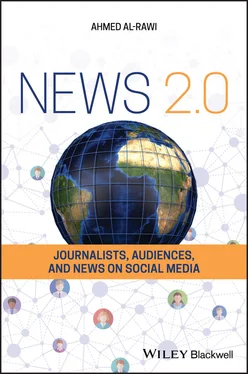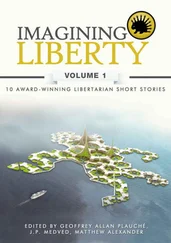Social media sites themselves have been fiercely competing to attract as many readers as possible in order to guarantee the flow of money from advertisers. Indeed, this advertising revenue has been drained from the news organizations themselves, especially local and small news outlets, which have been greatly impacted by the emergence of social media outlets, forcing many to shut down or downsize. According to a report by the Pew Research Center (2018), newspaper advertising revenues reached their climax in 2005 at over $49.4 billion, but declined precipitously coinciding with the advent of social media to an estimated $11.2 billion in 2017. In other words, social media platforms have indirectly played a major role in downsizing the news industry. Facebook realized early on the importance of news consumption on its platform. In 2015, the company signed a deal with nine famous news organizations, including the New York Times , the BBC, and the Guardian , in return for a share of the advertising revenues. This deal allows Facebook to host instant news stories on its platform, so users won't need to browse to other websites in order to discover them (Evans 2015). One survey shows that online users consume news on Facebook‐recommended pages more than they do pages recommended on Twitter, especially following the introduction of the Facebook Social Reader (Mitchell and Rosenstiel 2012), though this was shut down shortly after launching. While this survey deals with the US audience, it is important to mention the results of a Pew study here, which can provide a general insight into audiences' media habits in other regions. According to this study, about 30% of Facebook users get news onsite; this is higher than for any other SNS, including YouTube (10%) and Twitter (8%) (Pew Research – Journalism Project 2013).
Despite the financial and practical advantages of knowing the demographics and reading habits of online audiences, some communication scholars warn that the increasing obsession with what readers want to read or view can force news outlets into tailoring their stories and reports to fit their audiences' informational needs. In this regard, Shoemaker and Vos assert that “hard data about what readers want to read butts up against the social responsibility canon to give readers what they need to read” (2009, p. 7). Bright and Nicholls agree, and emphasize that while statistics on stories' popularity can be useful, they have also “created worries about the potential for populism online: that editorial judgment [will] be overridden by traffic statistics” (2014, p. 178). This view is bolstered by previous studies on how audience news clicks and online preferences can affect the placement of news stories and other vital editorial decisions in relation to news production and dissemination (Thurman 2011; Lee et al. 2014).
SNS news readers are not always engaged with or interested in everything posted by a news organization, even if they follow its Twitter or Facebook page, and there's no guarantee they will engage with a particular story beyond skimming the headline on SNS. For example, when NPR posted a story titled “Why Doesn't America Read Anymore?” to its Facebook page on April Fool's Day 2014, many online readers commented on it after reading just the headline, not the full story – which of course was the joke (Dickson 2014; NPR 2014). This example sheds light on the kind of weak involvement some online readers have with news, mostly due to time constraints. Yet, this phenomenon is not confined to news stories posted on SNS outlets. Earlier studies showed similar tendencies when it came to print and online media (Garcia et al. 1991; Holmqvist et al. 2003).
The other problematic issue with News 2.0 is that some indicators of popularity may be deceiving because of the use of bots, troll armies, and paid users. In addition, relying on one indicator may not always be a good option when studying News 2.0. For example, the public Facebook pages of news organizations show their number of likes or followers. This can be an important indicator of the popularity of some pages or outlets, but it does not necessarily reflect real engagement with news. To provide a clearer picture, I used Netvizz, a social media mining tool, in mid‐2017 to extract data from 26 Facebook pages belonging to different Arabic and English news media outlets. In total, I retrieved the metadata of 157 844 Facebook posts made between January 20, 2010 and April 13, 2017, which generated 326 257 464 reactions. The digital tool has a 10 000‐news‐stories limitation, and it is not clear whether all or most of the stories were retrieved, so there is a clear research limitation here. Regarding the more than 300 million Facebook reactions, they refer to the total number of likes and emotional reactions (wow, anger, haha, awe, and sad) but do not include the number of comments and shares. A whopping 91 out of 100 of the top posts belonged to Fox News ( Table 1.1), despite the fact that its Facebook page has far fewer likes than CNN and the BBC. These top 100 posts got 31 893 875 reactions, which is a useful reminder that researchers have to analyze several indictors before judging the popularity of, and audience engagement with, news organizations and their content.
In this book, I examine News 2.0 on different platforms, approaching the phenomenon from different angles using a variety of digital methods and computational journalism approaches. From the side of content and its producers, I mostly use news values theory to examine differences and similarities in news coverage, providing important insight into the nature of global and regional news flow. There are several studies that examine the comments sections of news sites using, for example, content analysis (Abdul‐Mageed 2008; McCluskey and Hmielowski 2012), but there are few empirical studies that have investigated the content of news stories posted on news organizations' SNS channels, especially from a cross‐national comparative perspective. Sonia Livingstone outlines the challenges of this type of research, but also highlights its many benefits, including “improving understanding of one's own country; improving understanding of other countries; testing a theory across diverse settings; examining transnational processes across different contexts … etc.” (2003, p. 479). This book purposefully uses many non‐English and non‐Western case studies. For decades, many scholars have been calling for a de‐Westernization of journalism, media, and communication research (Park and Curran 2000). Waisbord and Mellado define de‐Westernization as follows: “It is grounded in the belief that the study of communication has been long dominated by ideas imported from the West …. Underlying this position is the argument that ‘Western’ theories and arguments are inadequate to understand local and regional communication processes and phenomena” (2014, p. 362). The main premise behind the de‐Westernization trend is not a wholesale rejection of Western theories or media studies, but rather the “enrichment” of the available theories and methods (Wang 2010, p. 3). According to Shelton Gunaratne, de‐Westernization should refer to “the addition of multiple approaches to investigate problems in their proper context, so that factors such as culture, environment, ideology and power are not omitted from the theoretical framework or held to be constant (ceteris paribus)” (2010, p. 474). This is an issue on which Wasserman and de Beer principally agree, calling for in‐depth theoretical research rather than the mere provision of “descriptive comparative studies of journalism” (2009, pp. 428–429). One of the main problems of mainstream, Western media studies is its limited, Eurocentric and Anglo‐American coverage. For example, in their review of previous research done on news sharing, Kümpel, Karnowski, and Keyling surveyed a total of 461 research papers published between 2004 and 2014, and found that there was an obvious focus on studies that dealt with the United States (about 79%), with “only a few that addressed other countries and almost none that discussed possible cultural differences or actually made cross‐country comparisons” (2015, p. 10). Kümpel et al. recommend expanding news sharing studies “to multiple countries and cultural settings” (2015, p. 10). This suggestion was echoed by Wilkinson and Thelwall, who recommended examining “international differences in news interests through large‐scale investigations of Twitter” (2012, p. 1634). Hanitzsch, among others, has noticed obvious Western bias in the selection of academic research topics, which “giv[es] scholars from the Global North a considerable advantage” (2019, p. 214). Instead of relying on social media data in the English language alone, this book attempts to fill a major gap in the literature by examining data in the Arabic language as posted by a variety of news organizations, allowing a closer examination of international news.
Читать дальше












